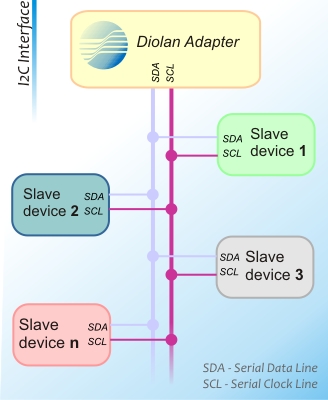I2C Bus Interface
 The I2C bus was developed by Philips Semiconductors (now NXP Semiconductors) as a simple serial bidirectional, 8-bit oriented, 2-wire bus.
The I2C bus was developed by Philips Semiconductors (now NXP Semiconductors) as a simple serial bidirectional, 8-bit oriented, 2-wire bus.
Each device is recognized by a unique address and can operate as either a receiver-only device (e.g., an LCD driver) or a transmitter with the capability to both receive and send information (such as memory). Transmitters and/or receivers can operate in either master or slave mode, depending on whether the chip has to initiate a data transfer or is only addressed. The I2C is a multi-master bus and can be controlled by more than one bus master connected to it.
Depending on the speed mode the I2C bus can operate at the following frequencies:
| I2C Bus Standard Mode | Transfer rate up to 100 kbit/s. |
| I2C Bus Fast Mode | Transfer rate up to 400 kbit/s. |
| I2C Bus Fast Mode Plus (Fm+) | Transfer rate up to 1 Mbit/s. |
| I2C Bus High Speed Mode | Transfer rate up to 3.4 Mbit/s. |
All DLN-series I2C bus adapters support transfer rate up to 1 Mbit/s (Fast-mode Plus).
The I2C bus requires two bus lines:
| SDA | a serial data line |
| SCL | a serial clock line |
I2C Bus Derivative Technologies
Due to the great success and applicability of the I2C bus, Atmel and other vendors implement the same protocol on various system-on-chip processors under the different names: TWI (Two Wire Interface) or TWSI (Two-Wire Serial Interface).
The I2C bus is used in a variety of control architectures such as:
- System Management Bus (SMBus)
- Power Management Bus (PMBus)
- Intelligent Platform Management Interface (IPMI)
- Advanced Telecom Computing Architecture (ATCA)
These I2C bus implementations have differences in voltage and clock frequency ranges, and may have interrupt lines.